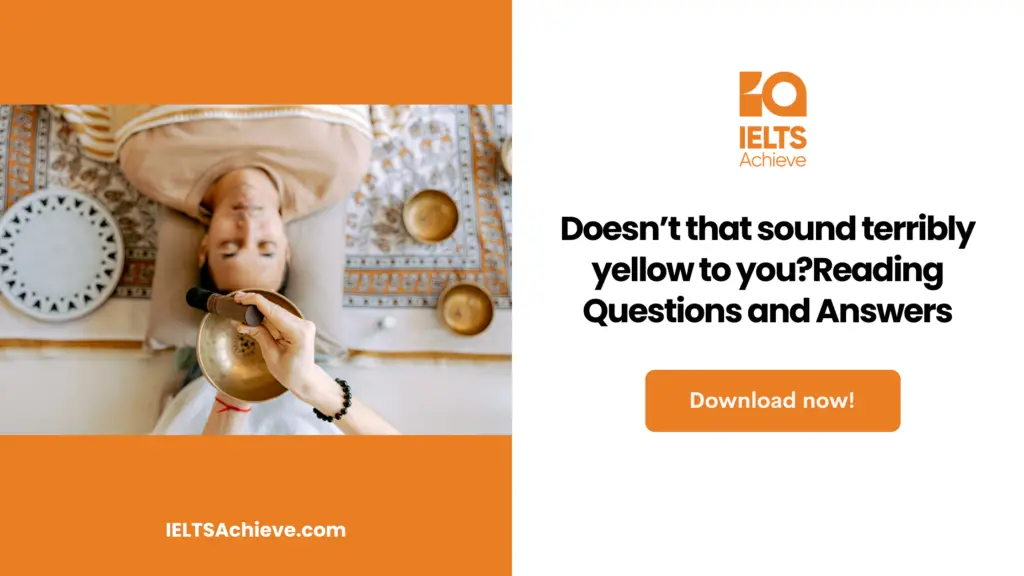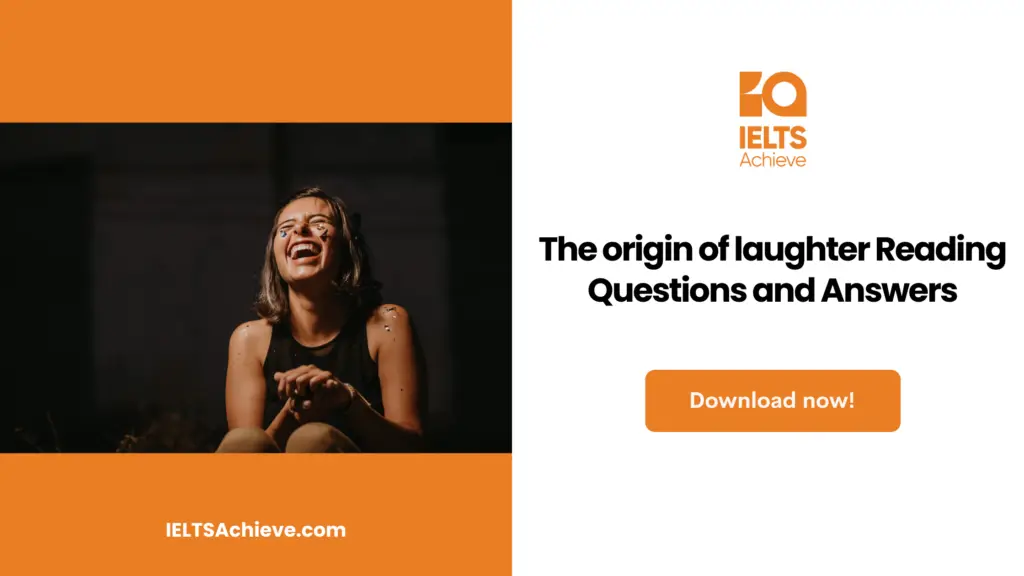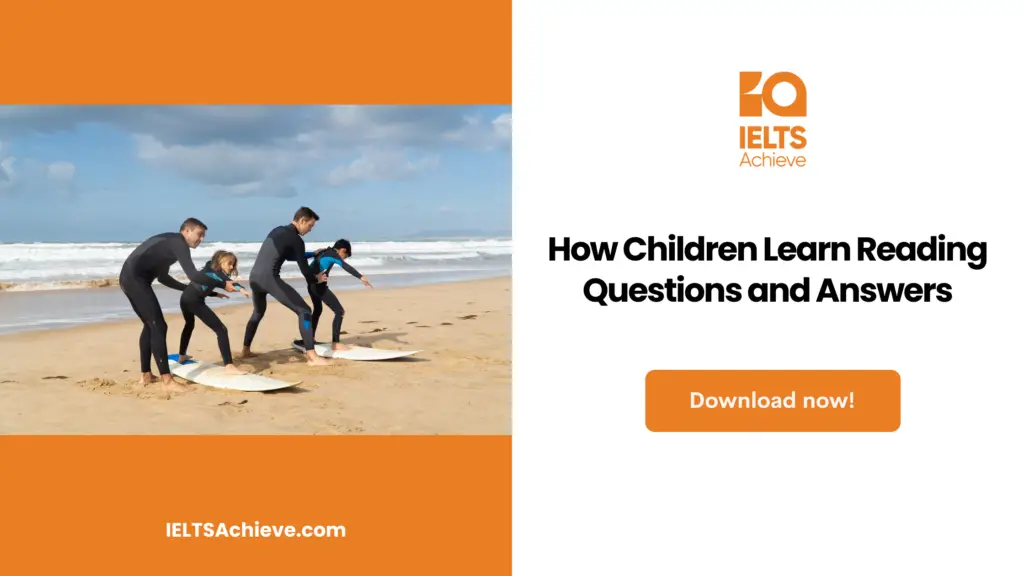The Blog post contains the following IELTS Reading Questions:
- IELTS Reading Multiple Choice Questions
- IELTS Reading Yes/No/Not Given
Stay informed and prepared for success – Explore our comprehensive Reading Test Info page to get valuable insights, exam format details, and expert tips for mastering the IELTS Reading section.
IELTS Reading passage – Doesn’t that sound terribly yellow to you?

Doesn’t that sound terribly yellow to you?
A. “I can’t say. I’m colour blind”, was my flatmate’s response. And that was that for another twenty-odd year when by chance I came across an article in a newspaper on research into synaesthesia at a London hospital. At last, I understood my interpretation of the world through colour. Synaesthesia is the subjective sensation of a sense other than the one being stimulated. For example, the sight of a word may evoke sensations of colour or the sound of music may also have a similar effect, as may the taste. Or, to put it simply, synaesthetes, i.e. people with synaesthesia, have their senses hooked together so that they experience several senses simultaneously. To those not already aware of it, synaesthesia seems a new phenomenon. Yet, it is far from new.
B. In 1690, John Locke, the philosopher, wrote of a blind man with synaesthetic capabilities. The first reference in the medical field was in 1710, by Thomas Woodhouse, an English ophthalmologist. In his Theory of Colour, the German writer, Goethe, talked about colour and the senses. The poet, Arthur Rimbaud, wrote about synaesthesia in his 1871 poem Voyelles, as did another French poet Baudelaire, in Correspondance. So, synaesthesia has a respectable history. Synaesthesia is understandably met with a certain degree of scepticism since it is something beyond the ken of the vast majority of people. Son et lumière shows in the 19th century were an attempt at combining the senses in a public display, but such displays were not capable of conveying the sensations experienced by involuntary synaesthesia, as the ability which a synaesthete’s experience is called.
C. There has been a number of well-documented synaesthetes. Alexander Scriabin, the Russian composer, (1871-1915) tried to express his own synaesthetic abilities in his symphony Prometheus, the Poem of Fire (1922). And another Russian, Rlmsky-Korsakov, noted the colour associations musical keys possessed. For example, Scriabin saw C major as red, while to Rimsky-Korsakov it was white. Arthur Bliss, an English composer, based his 1922 Colour Symphony on the concept of synaesthesia. He did not claim to be a synaesthete; his colour choices were arbitrary and the project an intellectual exercise. In the field of the visual arts, probably the best-known artist with synaesthetic capabilities is the Russian artist, Wassily Kandinsky (1866-1944), credited with being the founder of abstract painting.
D. It is said he experienced “sensory fusion” at a performance of Wagner’s Lohengrin, with the music producing colours before his eyes. He did not see colours solely in terms of objects but associated them with sounds. He even composed an opera, Der GelbeKlang (The Yellow Sound), which was a mixture of colour, light, dance and sound. For many people with synaesthesia, knowing that what they have been experiencing has both a name and a history and that they are among a number of notable sufferers is a revelation, Initially, they often feel that there is something wrong psychologically or mentally, or that everyone feds that way. Then they realise with a thud that other people do not. Suppression is an option, but unwittingly some people have managed to make use of the ability to their advantage.
E. While the condition of synaesthesia may hamper many people because of its disorienting effects, It can also open up a range of new skills, it is not unusual for people who have synaesthesia to be creative and imaginative, as many studies have shown, memory is based to some extent on the association. Synacsthctes find they are able to remember certain things with great ease. The person who associates the shape of a word with colour is quite often able to remember a long sequence of words, and the same goes for other areas where memory needs to be used. Cut this condition like all gifts, has its drawbacks, Some people see words as colours; others even individual letters and syllables so that a word becomes a kaleidoscope of colour. Beautiful though such a reading experience may be, synaesthesia can cause problems with both reading and writing, Reading can take longer because one has to wade through all the colours, as well as the words! And, because the colour sequences, as well as the words, have to fit together writing is then equally difficult.
Unlock your full potential in the IELTS Reading section – Visit our IELTS Reading Practice Question Answer page now!
Recommended Questions:
Renewable Energy IELTS Reading Question with Answer
Questions 1-4
Do the statements below agree with the information in Reading Passage? In Boxes 1-4, write:
Yes if the statement agrees with the Information in the passage
No, if the statement contradicts the information in the passage
Not Given If there is no information about the statement in the passage
Example: The writer is colour blind, Answer: No.
1) Synacsthctes experience several senses at the same time.
2) Newspaper articles and TV news reports about synaesthesia arc appearing with monotonous regularity nowadays.
3) Mention of synaesthesia can be traced back to the 17th century.
4) It is strange that many people are sceptical about synaesthesia.
Want to excel in identifying the writer’s views and claims? Click here to explore our in-depth guide on how to accurately determine Yes, No, or Not Given in the IELTS Reading section.
Question 5-8
Choose the appropriate letter A-D and write theme in Boxes 5-8 on your answer sheet.
5) Son et lumiere shows …
A. attempted to combine public senses
B. were frequent in the 19′” century
C. were both public and involuntary
D. did not reproduce the experiences of synacsthctes
6) Both Alexander Scriabin and Rimsky-Korsakov …
A. wanted to have synaesthetic abilities
B. created a lot of documents
C. linked music to colour
D. agreed with Bliss in 1922
7) The Russian artist, Wassily Kandinsky, …
A. performed Wagner’s Lohengrin
B. found abstract painting
C. also composed music
D. saw objects
8) At first, “sufferers” of synaesthesia believe that …
A. other people have similar experiences or there is something wrong with them
B. they are a revelation
C. they are psychologically or mentally superior
D. they are unique
Ready to improve your performance in Multiple Choice Questions (MCQs)? Click here to access our comprehensive guide on how to tackle MCQs effectively in the IELTS Reading section.
Questions 9-12
According to the reading passage, which of the following statements are true about synaesthetes? Write the appropriate letters in Boxes 9-12 on your answer sheet.
A. Some synacsthctcs are disoriented by their abilities.
B. Unusually, some synaesthetes hove great creativity.
C. Memory is heightened by synaesthesia.
D. Synaesthetes have gilts and drawbacks.
E. Some synaesthetes use their ability to help themselves.
F. Their ability can be an obstacle to them.
G. Some synaesthetcs write in colour.
Unlock your full potential in the IELTS Reading section – Visit our IELTS Reading Practice Question Answer page now!
Recommended Questions:
Renewable Energy IELTS Reading Question with Answer
Answers
1) Answer: Yes.
2) Answer: Not Given.
3) Answer: Yes.
4) Answer: No.
5) Answer: D.
6) Answer: C.
7) Answer: C.
8) Answer: A.
9-12) Answers: A, C, E, F.

We hope you found this post useful in helping you to study for the IELTS Test. If you have any questions please let us know in the comments below or on the Facebook page.
The best way to keep up to date with posts like this is to like us on Facebook, then follow us on Instagram and Pinterest. If you need help preparing for the IELTS Test, join the IELTS Achieve Academy and see how we can assist you to achieve your desired band score. We offer an essay correction service, mock exams and online courses.

